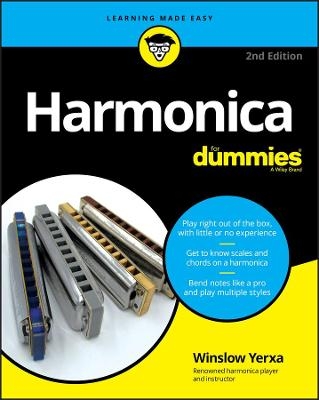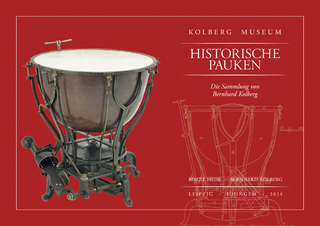
Harmonica For Dummies
For Dummies (Verlag)
978-1-119-70012-8 (ISBN)
The harmonica is one of the most popular and versatile instruments in the world. There are several reasons harmonicas are awesome—you can play them anywhere, they’re inexpensive, and you can show off in dozens of musical styles. The friendly and pleasingly tuneful Harmonica For Dummies is the fastest and best way to learn for yourself!
You’ll find an easy-to-follow format that takes you from the basics to specialized techniques, with accompanying audio and video content included to make learning even more simple and fun. Before you know it, you’ll be playing jazz in your living room and the blues on your way to work or school—and that’s just the prelude to mastering classical riffs. That’s right, the humble harmonica has graced some of the grandest concert halls on planet Earth!
Choose the right harmonica
Enhance your sound with tongue technique
Develop your own style
Perfect your live performance
The harmonica is awesome to learn, but even more awesome to&nlearn well, and Harmonica For Dummies will get you on the road from being an occasional entertainer to becoming an accomplished live performer.
P.S. If you think this book seems familiar, you’re probably right. The Dummies team updated the cover and design to give the book a fresh feel, but the content is the same as the previous release of Harmonica For Dummies (9781118880760). The book you see here shouldn’t be considered a new or updated product. But if you’re in the mood to learn something new, check out some of our other books. We’re always writing about new topics!
Winslow Yerxa is a widely known and admired harmonica player, teacher, lecturer, and author. He has written, produced, and starred in many harmonica books and video projects. He provides private harmonica instruction both online and in person in the San Francisco Bay area. He also offers classes, interviews, and lectures via the Harmonica Collective.
Introduction 1
About This Book 1
Foolish Assumptions 3
Icons Used in This Book 3
Beyond the Book 4
Where to Go from Here 4
Part 1: Getting Started with Harmonica 7
Chapter 1: What Is This Thing Called Harp? 9
Considering the Harmonica’s Coolness 9
Becoming the Next Harmonica Idol: What It Takes to Play 11
A harmonica 11
A little music know-how 11
Your body 12
Regular practice — and unstructured fun! 12
Taking Your Talent to the Next Level 13
Hanging Out in the Harmonica Village 14
Sharing your music with others locally 14
Visiting the repair shop and the accessory store 14
Chapter 2: Becoming a Harmonica Owner 17
Shopping for Your First Harmonica 18
Understanding the construction of the ten-hole diatonic 18
Tuning in to the key of the harp 19
Starting out with a harp in the key of C 19
Pricing a harmonica 20
Determining where to buy a harp 20
Safe and Sound: Caring for Your Harp 21
Collecting Additional Diatonic Harps 23
Purchasing popular keys 24
Expanding your range with harps in high and low keys 24
Adding Variety to Your Harmonica Kit 25
Chromatic harps 25
Tremolo and octave harmonicas 27
Making Your Harps Portable with Carrying Cases 28
Getting to Know You: Discovering How a Harmonica Works 29
Making a five-layer tin sandwich 29
Taking a closer look at the reeds that make the sound 30
Locating different notes 31
Chapter 3: Making Your First Harmonica Sounds 33
Preparing to Play the Harmonica 33
Picking up the harp 34
Putting the harp in your mouth 34
Breathing through the harp 35
Moving through the holes 35
Getting Acquainted with Some Musical Concepts 36
Zeroing in on harmonica tab 36
Counting with musical time 36
Locking in with the beat 37
Using beats as building blocks 39
Developing Your Sound 44
Expanding and sustaining your breathing 44
Cupping the harp in your hands 47
Nestling the harmonica in your mouth 50
Playing some cool rhythms 50
Chapter 4: Relating to Notes, Scales, and Chords 55
Getting in Tune with the Singable Notes 56
Understanding the curious phenomenon of octaves 56
Naming the notes and creating a scale 57
Using octaves to name all the notes 57
Altering pitches with sharps and flats 58
Measuring small distances with semitones and whole tones 59
Sizing Up Intervals 60
Counting out the size of an interval 60
Determining the quality of an interval 61
Finding the Key of a Song 62
Stepping Through Scales 63
Diatonic and chromatic scales 63
Major and minor scales 64
Modal scales 66
Altering a scale with sharps and flats 66
The Building Blocks of Chords 67
Four basic types of chords 68
Adding notes to basic triads 68
Chord progressions 69
Writing Notes Down 70
Placing notes on a staff 70
Writing sharps and flats on the staff 72
Unlocking key signatures 72
Finding harmonica notes on the staff 73
Part 2: Starting to Make Some Music 75
Chapter 5: I Hear a Melody: Playing Single Notes 77
Shaping Your Mouth to Single Out a Note 78
Forming the pucker embouchure 78
Producing a tongue-block embouchure 80
The Elements of Motion: Moving from One Note to the Next 81
Exploring breath changes 82
Finding your way with hole changes 83
Alternating breath changes and hole changes 85
Coordinating simultaneous hole changes and breath changes 86
Exploring the Three Registers of the Harmonica 87
Playing Familiar Tunes in the Middle Register 88
“Good Night, Ladies” 89
“Michael, Row the Boat Ashore” 89
“Mary Had a Little Lamb” 90
“Amazing Grace” 91
Making Your First Multi-Hole Leaps 92
“Twinkle, Twinkle, Little Star” 92
“Frère Jacques” 92
“On Top of Old Smokey” 94
Shifting up from the Middle 95
“Bunessan” (“Morning Has Broken”) 95
“Joy to the World” 96
Floating in the High Register 97
“Aura Lea” (“Love Me Tender”) 98
“She’ll Be Comin’ ’Round the Mountain” 99
“Silent Night” 100
Chapter 6: Shaping Your Sound 103
Enlarging Your Sound with Projection 104
Using your air column 104
Enriching your sound with the smooth swimming exercise 104
Increasing airflow through the reeds 106
Varying your volume with dynamics 109
Projecting with your hands 110
Starting and Ending Notes with Articulation 112
Starting notes with your tongue 113
Using your throat to articulate notes 115
Initiating a note with your diaphragm 116
Shaping the Tone Color of Your Notes 118
Changing vowel sounds with your tongue 118
Brightening and darkening your sound using your hands 119
Slowly changing the sound 119
Combining hand and tongue vowels 120
Pulsating Your Notes with Vibrato 120
Diaphragm vibrato 121
Throat vibrato 122
Tongue vibrato 123
Hand vibrato 123
Synchronizing and layering pulsation 124
Chapter 7: Enhancing Your Sound with Your Tongue on the Harp 127
Using Your Tongue to Combine Chords and Melodies 128
Knowing the chords on your harp 128
Accompanying melodies with chords 129
Chasing the beat with a chord 131
Reinforcing Melody Notes with Your Tongue 132
Applying the tongue slap 133
Popping chords with pull-offs 133
Creating Chord Textures with Your Tongue 135
Alternating tongue placements to produce the chord rake 136
Lifting and replacing your tongue to play a chord hammer 137
Rapidly alternating widely spaced notes with the shimmer 138
Combining Widely Spaced Notes with Splits 139
Sticking with a locked split 139
Inching along with variable splits 140
Playing Quick and Wide Leaps with Corner Switching 145
Chapter 8: Bending Notes 149
Knowing the What and the Why of Bending 150
What is bending? 150
Why bend notes? 151
Getting Started with Bending Notes Down 151
Exploring the roof of your mouth 152
Making some helpful noises 153
Creating your bend activator with the K-spot 154
Playing your first bend 156
If at first you don’t succeed: Practicing persistence 158
Deepening Your Skills at Bending Notes Down 159
Surveying the bendable notes 159
Working through the four stages of bending control 162
Bending draw notes down in the middle register 163
Bending draw notes down in the heart of the harp — the low register 165
Bending blow notes down in the high register 170
Bending on Different Types of Harmonicas 174
Chromatic harps 174
Double reed harps 175
Chapter 9: Positions: Playing One Harp in Many Keys 177
Understanding How Positions Help Your Playing 177
Figuring Out a Position 179
Relating Positions, Modes, and Avoid Notes 181
Rocking with Six Popular Positions 182
First position (C on a C-harp) 183
Second position (G on a C-harp) 185
Third position (D on a C-harp) 188
Fourth position (A on a C-harp) 190
Fifth position (E on a C-harp) 193
Twelfth position (F on a C-harp) 195
Part 3: Growing Beyond the Basics 199
Chapter 10: Fancy Playing: Developing Flair and Speed 201
Mastering Melody from the Ground Up 202
Seeing the scale 203
Recognizing scale patterns 204
Anchoring melodies on chord notes 209
Simplifying the scale to five notes 211
Adding Ornaments to the Melody 214
Shakes 214
Rips, boings, and fall-offs 215
Grace notes 215
Developing Your Speed 216
Start slow and know each individual move 216
Learn in small chunks 217
Speed it up — slowly 217
Think and play in larger units 217
Chapter 11: Mastering New Songs 219
Understanding How Songs Work 219
The container: Structuring time 219
The shifting backdrop: Chord changes 221
The foreground: Melody 221
Choosing the Right Harp 222
What are the notes in the scale? 222
What are the notes in the chords? 223
Making It Up versus Playing It Straight 225
Learning melodies 225
Jamming on a tune 226
Trial and Error: Playing Along with Random Music 227
Chapter 12: Behind the Hidden Treasure: Bending Notes Up 229
Considering the Coolness of Overbends 230
Playing more licks, riffs, and scales 230
Playing in more keys 231
Exploring the Things to Know Before You Start 232
How to choose a suitable harmonica 232
Determining which notes overblow and overdraw 232
Preparing your mind, body, and ears 235
Getting Your First Overblows 236
The push-through approach 236
The springboard approach 238
Achieving More Overblows 239
Getting Your First Overdraws 239
Raising the Pitch of an Overbend 241
Playing overbends in tune 241
Bending overbends up241
Blending Overbends into Your Playing 242
Strengthening your overbend approaches 242
Smoothing your follow-ons 244
Part 4: Developing Your Style 245
Chapter 13: Rockin’ and Bluesin’ 247
Getting Hip to the Blues/Rock Approach 248
The Three Basic Chords of Rock-and-Roll, Blues, and Nearly Everything 249
The Three Popular Harmonica Positions 249
Relating positions to chords and scales 250
Second position and the three basic chords 250
First position 251
Third position 251
Playing Sweet Melodies in First Position 252
“Kickin’ Along” 252
“Youngish Minor” 253
“Morning Boots” 254
The 12 Bars of Blues 255
Making a statement: Tell it, brother! 255
Fitting the notes to the chords 256
Exploring 12-Bar Blues with Second Position 257
“Ridin’ the Changes” 257
Driving the rhythm with “Lucky Chuck” 258
“Buster’s Boogie” 259
Adding Minor Chords to a Progression: “Smoldering Embers” 261
Adding the Flat III and Flat VII Chords: “John and John” 263
Burning in Third Position: “Tom Tom” 264
Chapter 14: Expressing Yourself with Some Folk and Gospel Melodies 267
Sampling Some First-Position Songs 268
“Buffalo Gals” 268
“Wildwood Flower” 269
“La Cucaracha” 270
Getting Acquainted with a Few Second-Position Songs 271
“Since I Laid My Burden Down” 272
“Cluck Old Hen” 273
“Aura Lea” in second position 273
“This Train (Is Bound for Glory)” 274
Inhaling Some Third-Position Melodies 276
“Little Brown Island in the Sea” 277
“She’s Like the Swallow” 278
Exploring Folk Songs in Twelfth, Fourth, and Fifth Positions 279
“À la claire fontaine” in twelfth position 279
“The Huron Carol” in fourth position 280
“Poor Wayfaring Stranger” in fifth position 281
Chapter 15: Fiddlin’ the Night Away with Traditional Dance Tunes 283
Choosing Harps for Playing Folk and Celtic Music 284
The tremolo harmonica 284
The chromatic harmonica 285
Playing Fast Fiddle Tunes 285
Trying Out Some First-Position Tunes 286
“Jerry the Rigger” 286
“Soldier’s Joy” 287
“The Stool of Repentance” 289
Energizing Some Tunes in Second Position 290
“Over the Waterfall” 290
“Angeline the Baker” 292
“Bat Wing Leather” 294
Feeling the Excitement of Third-Position Tunes 295
“Dorian Jig” 295
“The Dire Clog” 295
Part 5: Taking It to the World 299
Chapter 16: Putting It All Together — Your Tunes, Your Band, Your Listeners 301
Putting Your Tunes Together 302
Selecting tunes for the harmonica 302
Making it your own: Arranging a tune 304
Adding vocals to your tunes 306
Making Music with Others 306
Setting some ground rules when you play with others 306
Knowing when to lay out 308
Playing in a duo 308
Jamming with a band 309
Strutting Your Stuff Onstage 310
Looking good, feeling good 310
Preparing for an onstage performance 310
Overcoming stage fright 311
Recovering from mistakes 312
Taking center stage: Soloing 312
Chapter 17: Amplifying Your Sound 313
Getting Acquainted with Amplification Basics 314
Playing through a Microphone for the First Time 314
Playing into a microphone on a stand 315
Playing with a microphone cupped in your hands 316
Hearing yourself through the chaos 317
Avoiding the dreaded howl of feedback 318
Taking Amplification to the Next Level: Clean and Distorted Amplified Sound 319
Getting better acquainted with microphones 319
Altering a harp’s sound with effects 321
Cranking it up with amplifiers, preamps, and speakers 322
Connecting Mics, Amplifiers, and Effects Units 324
Chapter 18: Improving Your Harmonica with Repairs and Upgrades 327
Gathering the Tools You Need 328
Following Good Repair Practices 329
Making Three Simple Improvements 330
Disassembling and reassembling a harp 330
Flexing the reeds 331
Smoothing sharp edges and corners 332
Diagnosing and Fixing Problems 332
Taking a harp apart and putting it back together 334
Clearing obstructions from your harp 336
Fixing reeds that are misaligned 337
Narrowing reed slots 337
Setting reed action 338
Tuning your harmonica 342
Part 6: The Part of Tens 347
Chapter 19: Ten (Or More) Ways to Connect in the Harmonica World 349
Take Lessons from a Pro 349
Enjoy Harmonica Performances 350
Seek Out Musical Events That Don’t Focus on Harmonica 350
Let Loose at Jam Sessions and Open Mic Nights 350
Contribute to Harmonica Discussion Groups Online 351
Surf Informational Websites 352
Use Paid Content Learning Sites 353
Join a Harmonica Club 354
Share Your Enthusiasm at Harmonica Festivals 354
Sign Up for a Harmonica Seminar 355
Advertise 356
Chapter 20: Way More Than Ten Harmonica Albums You Should Hear 357
Blues 358
Rock 359
Bluegrass/Old-Timey 360
Celtic 360
Country 361
Gospel 362
Jazz 362
Part 7: Appendixes 365
Appendix A: Tuning Layouts for All Keys 367
Appendix B: Audio Tracks and Video Clips 373
The Audio Tracks 373
The Video Clips 380
Customer Care 381
Index 383
| Erscheinungsdatum | 27.10.2020 |
|---|---|
| Sprache | englisch |
| Maße | 183 x 234 mm |
| Gewicht | 567 g |
| Themenwelt | Kunst / Musik / Theater ► Musik ► Instrumentenkunde |
| ISBN-10 | 1-119-70012-4 / 1119700124 |
| ISBN-13 | 978-1-119-70012-8 / 9781119700128 |
| Zustand | Neuware |
| Haben Sie eine Frage zum Produkt? |
aus dem Bereich


